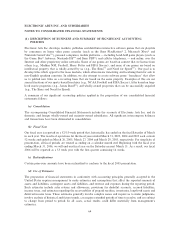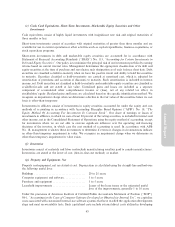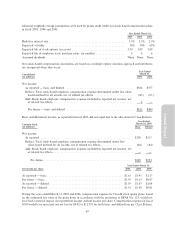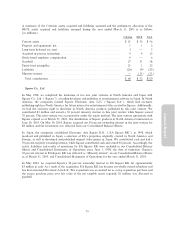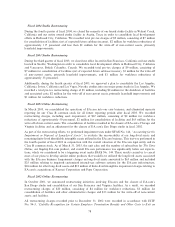Electronic Arts 2005 Annual Report Download - page 129
Download and view the complete annual report
Please find page 129 of the 2005 Electronic Arts annual report below. You can navigate through the pages in the report by either clicking on the pages listed below, or by using the keyword search tool below to find specific information within the annual report.
indicators have come to our attention suggesting that the investment is impaired. Accordingly, we do not
consider these investments to be other-than-temporarily impaired as of March 31, 2005. During Ñscal 2004, no
other-than-temporary impairments in investments in aÇliates were recognized. However, during Ñscal 2003,
we determined that some of our cost method investments contained other-than-temporary impairments based
on several factors such as the Ñnancial performance of the aÇliate, our decision to no longer acquire or
continue investing in the aÇliate, the limited cash Öow from future business arrangements and other
information available, and a charge of $11 million was recorded to write-down these investments to their
estimated fair market value.
(3) DERIVATIVE FINANCIAL INSTRUMENTS
We account for our derivative and hedging activities under SFAS No. 133. The assets or liabilities associated
with our derivative instruments and hedging activities are recorded at fair value in other current assets or other
current liabilities, respectively, in the Consolidated Balance Sheets. As discussed below, the accounting for
gains and losses resulting from changes in fair value depends on the use of the derivative and whether it is
designated and qualiÑes for hedge accounting.
We transact business in various foreign currencies and have signiÑcant international sales and purchase
transactions denominated in foreign currencies. As a result, we purchase foreign currency option contracts,
generally with maturities of 15 months or less, to reduce the volatility of cash Öows primarily related to
revenue generated by our international subsidiaries. In addition, we utilize foreign exchange forward contracts
to mitigate foreign currency exchange rate risk associated with foreign-currency-denominated assets and
liabilities, primarily intercompany receivables and payables. The forward contracts generally have a contrac-
tual term of less than one month and are transacted near month-end. Therefore, the fair value of the forward
contracts generally is not signiÑcant at each month-end. We do not use foreign currency option or foreign
exchange forward contracts for speculative or trading purposes.
Cash Flow Hedging Activities
Our foreign currency option contracts are designated and qualify as cash Öow hedges under SFAS No. 133.
The eÅectiveness of the contracts that qualify as cash Öow hedges is assessed monthly through an evaluation
of critical terms and other criteria required by SFAS No. 133. The eÅective portion of gains or losses resulting
from changes in fair value is initially reported as a component of accumulated other comprehensive income or
(loss), net of any tax eÅects, in stockholders' equity and subsequently reclassiÑed into net revenue in the
period when the forecasted transaction actually occurs. The ineÅective portion of gains or losses resulting from
changes in fair value is reported in interest and other income, net in the Consolidated Statements of
Operations. We expect the eÅective portion of hedges recognized in accumulated other comprehensive income
Annual Report
or (loss) as of March 31, 2005, will be reclassiÑed to net revenue during Ñscal 2006. The amount of hedging
ineÅectiveness recognized in interest and other income, net was a loss of $1 million and $2 million for the
years ended March 31, 2005 and 2004, respectively.
Balance Sheet Hedging Activities
Our foreign exchange forward contracts are not designated as hedging instruments under SFAS No. 133.
Accordingly, any gains or losses resulting from changes in the fair value of the forward contracts are reported
in interest and other income, net in the Consolidated Statements of Operations. The gains and losses on these
forward contracts generally oÅset the gains and losses associated with the underlying foreign-currency-
denominated assets and liabilities.
(4) BUSINESS COMBINATIONS
Criterion
On October 19, 2004, we completed our acquisition of 100 percent of Criterion Software Group Ltd.
(""Criterion'') for an aggregate accounting purchase price of approximately $68 million including transaction
costs and the assumption of outstanding stock options under certain Criterion stock option plans. Based in
73



